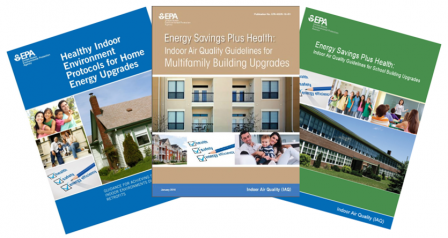Health, Energy Efficiency and Climate Change
On this page:
Climate Change and Indoor Environments
Climate change may worsen existing indoor environmental problems and indoor air quality, and it may also introduce new problems as the frequency or severity of adverse outdoor conditions change. Our homes and buildings, where we spend most of our time, provide protection between us and the outdoors. The design, construction, operation and maintenance of buildings can impact the air we breathe, our energy consumption, and our health. To protect all building occupants and maintain safe and healthy indoor environments, considerations for buildings should include occupant health and well being, sustainability, energy efficiency, and changing outdoor conditions.
Learn about:
- Adapting Buildings for Indoor Air Quality in a Changing Climate
- Take Action for Climate Readiness and Indoor Air Quality
Energy Efficiency and IAQ
Heating and cooling buildings uses a lot of energy — about 43 percent of all energy use in the United States. Producing this energy requires us to burn fossil fuels like coal and oil, which contributes to air pollution and generates large amounts of greenhouse gases that contribute to climate change.
Improving the energy efficiency of buildings usually involves tightening the buildings through air sealing and other weatherization techniques to reduce the escape of air that we have just spent money to heat or cool. That’s a very good thing. However, as buildings are renovated or repairs are made to save energy or increase comfort, indoor air quality problems can be created or exacerbated. Indoor pollutants like radon, mold, particles and chemicals from a variety of sources can build up to unhealthy levels unless pollutant sources, ventilation and moisture are carefully managed. Pollutants like tobacco smoke can easily migrate from one unit to another in multi-unit buildings, and lead and asbestos, which may be disturbed during renovations or retrofits, remain serious health risks in older buildings.
Protecting indoor air quality and occupant health while saving energy and money during building retrofits isn’t very hard to do, but it does require teamwork, planning and commitment from everyone involved in building upgrades. Most importantly, if we do it right, we’ll protect public health, reduce our reliance on fossil fuels and reduce climate change impacts all at the same time. Learn more about how weatherization and other energy upgrades may impact IAQ.
Guidance and Tools for Protecting IAQ During Building Upgrades
EPA has developed a suite of three practical guides for single and multifamily homes and schools, to help everyone involved in building renovations--whether for energy efficiency or other purposes--protect and even improve indoor air quality.
- Energy Savings Plus Health IAQ Guidelines for Multifamily Building Upgrades
- Healthy Indoor Environment Protocols for Single Family Home Energy Upgrades
- Protecting IAQ During School Energy Efficiency Retrofit Projects with Energy Savings Plus Health Guidelines

